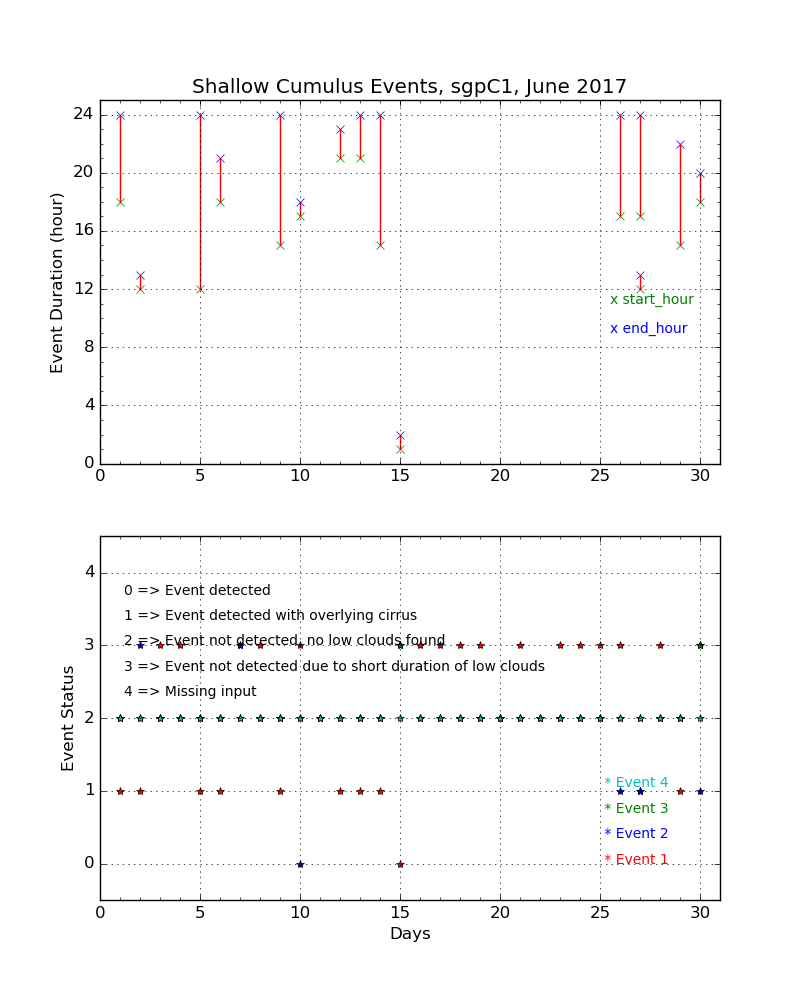REVISED: New Shallow Cumulus VAP Available
Published: 15 October 2019

Editor’s note (October 15, 2019): Additional data for the Shallow Cumulus value-added product (VAP) have been released. Data are now available for the Southern Great Plains atmospheric observatory from July 2, 2000, through May 31, 2019. The Shallow Cumulus VAP will be run operationally on additional data from the Active Remote Sensing of Clouds using Ka-Band ARM Zenith Radars (KAZR-ARSCL) VAP as they become available. Evaluation of this product is documented in a new paper available online and in the technical report on the VAP web page.
A new data product—the Shallow Cumulus value-added product (VAP)—automatically detects periods of shallow cumulus clouds using information from vertically pointing active sensors and the total sky imager, which measures the fraction of sky covered by clouds. Data from the VAP are currently available for the Atmospheric Radiation Measurement (ARM) user facility’s Southern Great Plains (SGP) atmospheric observatory from 2000 to 2018.
The VAP uses a one-hour time resolution and only classifies events as shallow cumulus when low clouds are detected for at least 1.5 hours and meet specified criteria for cloud occurrence and cloud fraction. The VAP also identifies cases with overlying cirrus or transitions to and from different cloud types.
Two kinds of files are produced by this VAP. Daily files contain detailed information about which criteria a time period failed or passed to be identified as a shallow cumulus event (sgpshallowcumulusC1.c1). Monthly summary files (sgpshcusummaryC1.c1) collect that information into a synthesized view of what hours contain shallow cumulus events over the course of the month.
Inputs for the Shallow Cumulus VAP include the Cloud Type Classification (CLDTYPE) VAP, which classifies clouds using cloud boundaries from the Active Remote Sensing of Clouds (ARSCL) VAP, and cloud fraction from the total sky imager and ceilometer.
Developed to identify potential cases of interest for the Large-Eddy Simulation (LES) ARM Symbiotic Simulation and Observation (LASSO) workflow, the Shallow Cumulus VAP is designed to err on the side of identifying false positives rather than missing events. Additional information is available in the VAP to help users narrow cases to those of interest, such as flags indicating whether overlying cirrus was found.
The Shallow Cumulus VAP will be run operationally on additional ARSCL data as they become available.
A publication is being written showing the evaluation of this product (Lim et al., “Long-term cloud type retrieval using a combination of active remote sensors and a total sky imager at the ARM SGP site,” in progress).
Feedback on the VAP can be sent to Laura Riihimaki.
More information on the Shallow Cumulus VAP is available on the VAP web page. To access these data, log in to the ARM Data Center. (Go here to request an account.)
To cite the Shallow Cumulus data, please use doi:10.5439/1392569.
Keep up with the Atmospheric Observer
Updates on ARM news, events, and opportunities delivered to your inbox
ARM User Profile
ARM welcomes users from all institutions and nations. A free ARM user account is needed to access ARM data.


















